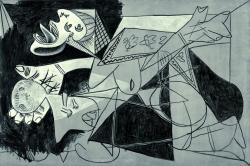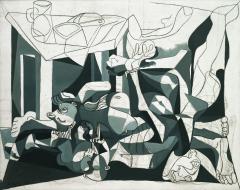Exhibition Reviews
| Home | | Museum Guide | | International | | Theater |
Rediscovering Picasso, But Without Colors
By Adèle Bossard
It is quite unusual to think of Picasso's work as composed of a black and white palette, although everyone remembers “Guernica,” Picasso's gigantic response to the 1937 bombing of a Basque village by German and Italian warplanes. Picasso claimed that “color weakens” and his exploitation of the black and white colors transcends all the established periods that have been assigned to his artistic career. The exhibition “Picasso Black and White” at the R. Solomon Guggenheim Museum in New York pays tribute to this facet of his prolific career, featuring 118 black and white paintings, sculptures or works on paper, realized between 1904 and 1971. Pablo Picasso was born in 1881 in Málaga, Spain and began to draw at the early age of 13. His family moved to Barcelona in 1985, where Pablo studied atthe Academy of Fine Arts. He settled in Paris in 1904, the date of the first work presented in the show. Thirty-eight of these works have never been exhibited in the United States before and five of them have never even been on view publicly. The collection is organized chronologically around the Guggenheim rotunda and crosses over all the established periods of the artist's career. Ironically, the “Blue Period” and the “Rose Period” are the two first stages of Picasso's career that are illustrated in this black and white exhibition. “Woman Ironing,” from 1904, is the first painting on display and chronologically belongs to the “Blue Period” of Picasso's artistic career with its muted tones of blue and gray. This period coincides with the suicide of his close friend Casagemas, who shot himself in a Parisian cafe in 1901. Using only shades of blue or blue-green, it clearly exudes feelings of worry and loneliness. The “Rose Period” that follows is characterized by a more cheery style, using an orange or pink palette, illustrated in this exhibition with tints of white and lighter gray.
The retrospective highlights the fact that Picasso's use of black and white crosses over his whole career, from the happiest moments of his love stories to the darkest sides of the European history. For instance, World War I, from 1914 to 1918, changed the life, mood, state of mind and of course art of the artist: its pictures became somber, closer to reality. His paintings from the 1930's and 1940's obviously reflect the torments in Europe at this time. If “Guernica” itself isn't on display, several sketches of the painting are, notably “Head of a Horse, Sketch for Guernica” or the poignant “Mother with Dead Child II, Postscript for Guernica.” During this period, the use of monochromatic colors gives a special power to the paintings, with a stronger contrast and sharper lines. It is viewable on the still lives of this period too, notably those realized when Paris was occupied by the Nazi forces.
The “Charnel House” concludes the series Picasso had started with “Guernica” and echoes the discovery of the horrifying concentration camps. Once again, the severe tones and the complex composition of structures and forms allows a powerful depiction of the atrocities of war. The last paintings on display, from the end of the 1940's and after, carry a lighter message than during the war period, as Picasso used the art of painting to express his own feelings until the end of his life, in 1973. Indeed, pictures from this time mainly depict scenes on abeach, portraits of women or representation of kisses. The Tuesday morning I went, the Guggenheim was partly devoted to a
children's tour. The museum was crowed with groups of kids enthralled
by Picasso's art, trying in their turn to draw in the cubist way. Picasso
once said “When I was as old as these children, I could draw like
Raphael, but it took me a lifetime to learn to draw like them”.
If you go:
Adèle Bossard is a free lance writer from Saumur, France.
|



